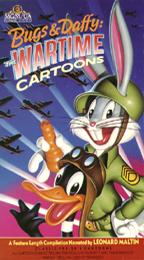| Bugs & Daffy: The Wartime Cartoons | |
|---|---|
 VHS cover | |
| Produced by | Ralph Tribbey |
| Starring | Mel Blanc (voice) |
| Edited by | Johen Bohn |
| Distributed by | MGM/UA Home Video |
Release date |
|
Running time | 90 minutes |
| Country | United States |
| Language | English |
Bugs & Daffy: The Wartime Cartoons is a 1989 direct-to-video program by MGM/UA Home Video, containing 11 Looney Tunes and Merrie Melodies shorts, all of which are centered on World War II. Film critic Leonard Maltin ( Entertainment Tonight ) tells trivia and facts about each animated short. [1] [2] [3] [4]